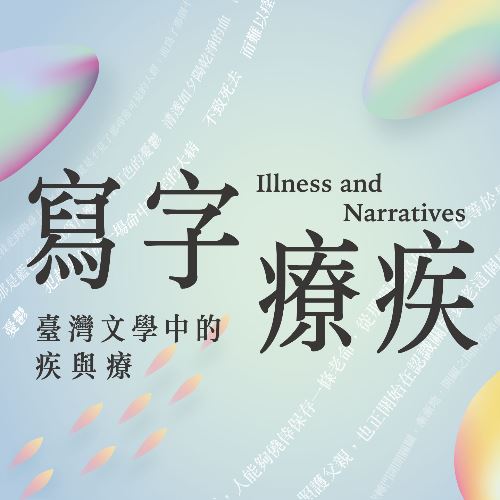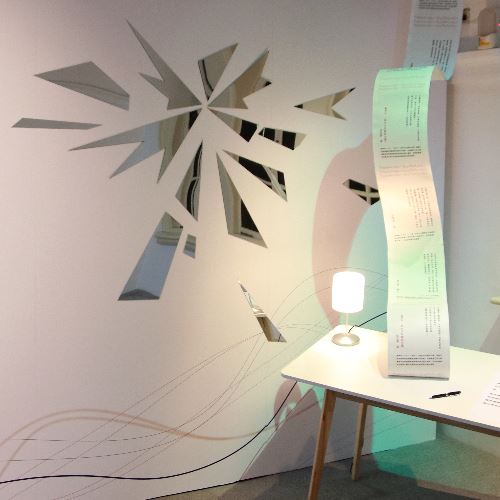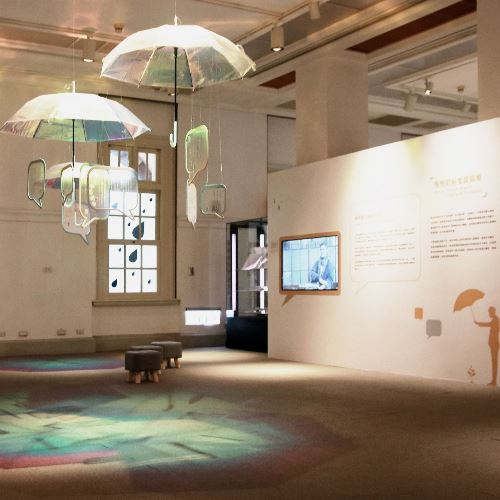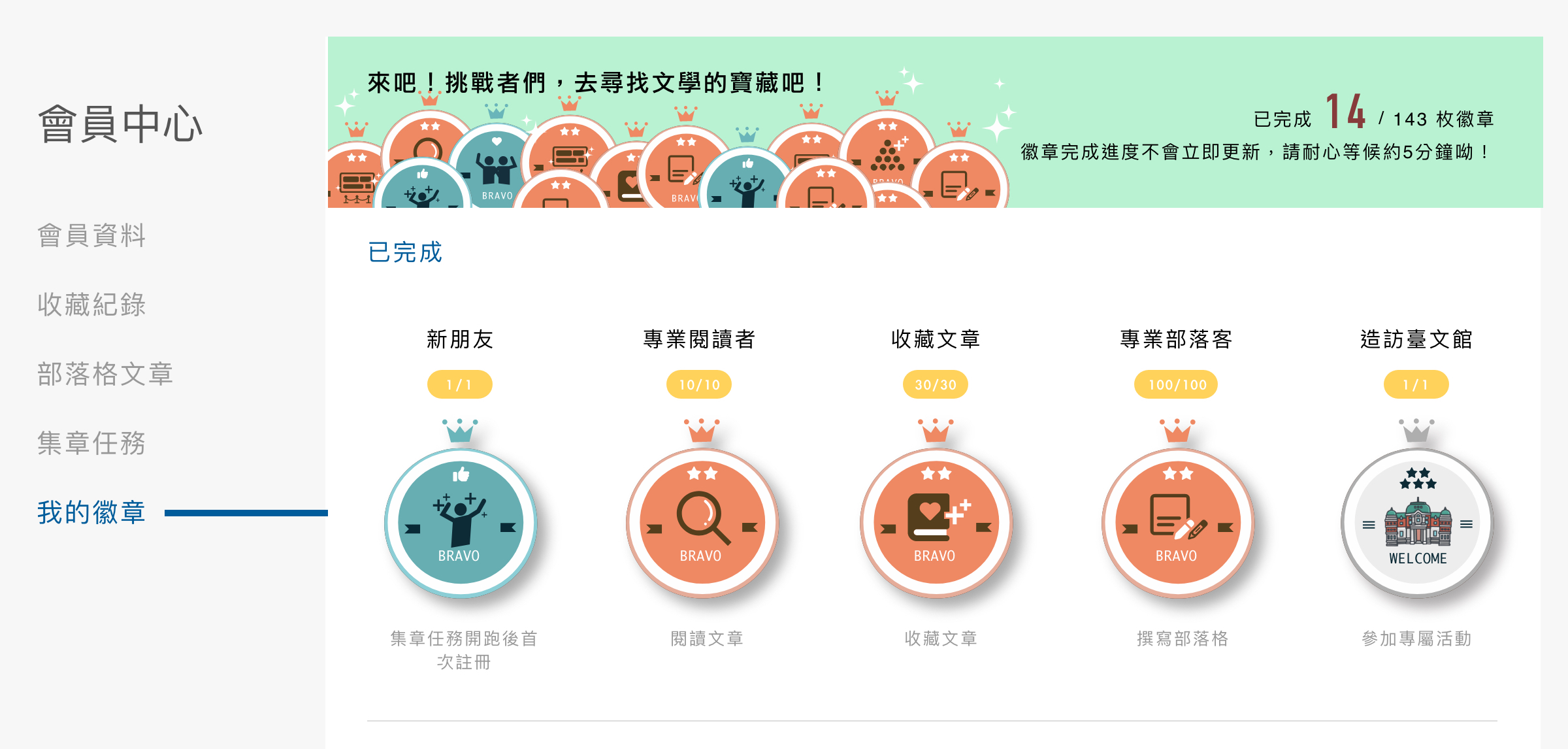►10 Seconds of Disaster, A Decade of Recovery ►Literature Gives Voice to Silent Pains
►War's Clamor vs. Literature's Quietude ►Navigating Memories, Rectifying History
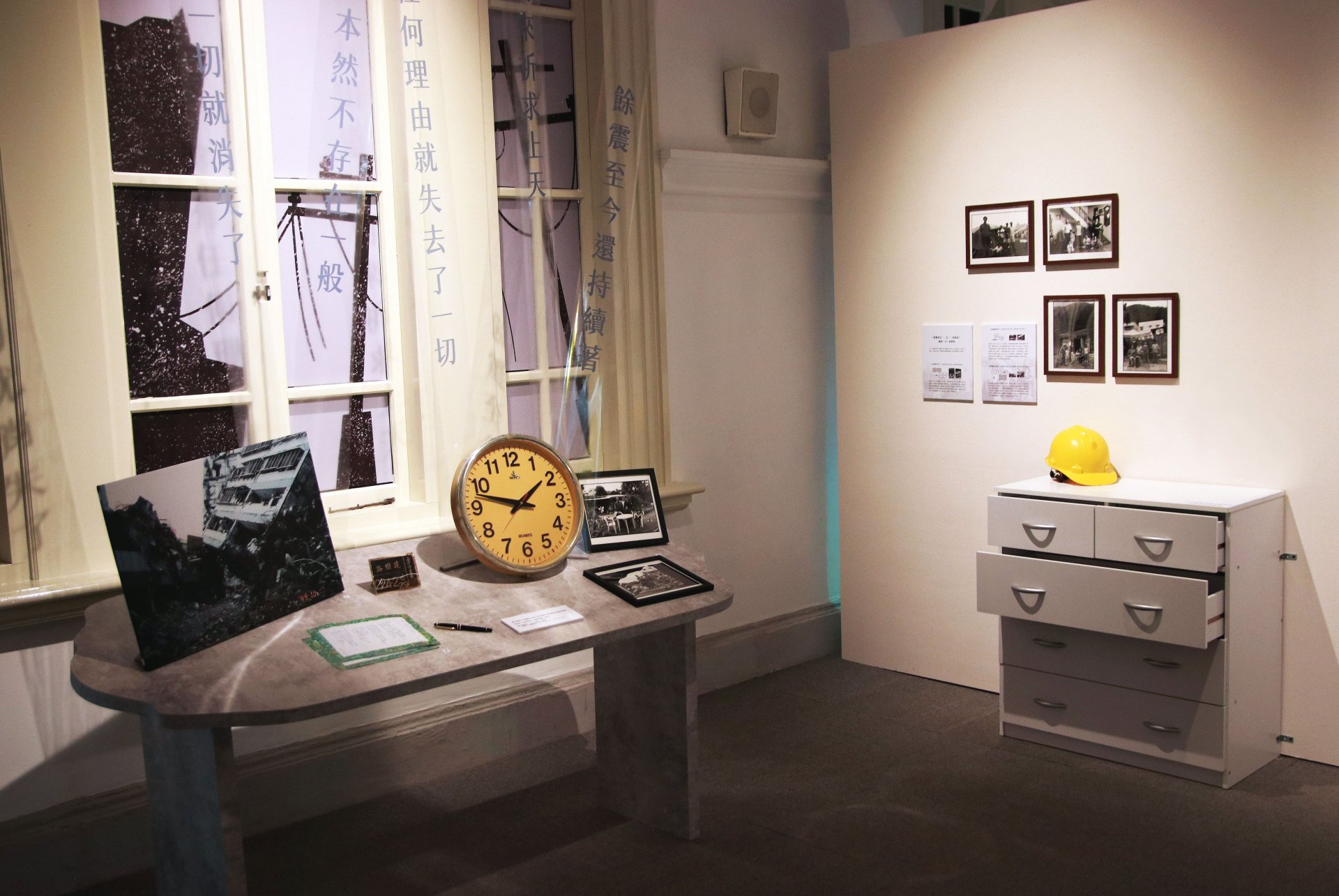
Trauma refers to a short-term impact on the mind that leaves an indelible scar; the scar will continue to cause pain and influence one's psychology in the long run. Posttraumatic stress disorder (PTSD) patients might be overly wary or become numb and emotionless. They might also feel panicky again when triggered by a dream or memory.
Any major incident that might impact a person's life, including natural disasters, work injuries, wars, and political oppressions, may damage one's house and body and leave emotional scars. There are ways of treating physical harm; yet mental traumas are difficult for others to understand. There are remedies for both physical and psychological pain but sometimes understanding the cause of pain is only possible by returning to the past.
Literature searches the origin of the pain and empathizes with those involved; it also allows others who have never been through the same incident to take a closer look. Complete empathy is not easy; yet, writing and reading may serve as a starting point so that recounting the past can become a path to the future and the healing process can be initiated.
10 Seconds of Disaster, A Decade of Recovery
As Taiwan belongs to the tropical climate zone and is located at a plate boundary, it has long suffered from typhoons and earthquakes. Natural disasters are powerful and often kill numerous lives in just a few days or a few seconds. Apart from physical harm, those who manage to survive might be terribly traumatized. Any shaking or rain hitting the window can cause insomnia or restlessness.
Literature attempts to soothe a traumatized mind and captures the moment when a disaster occurs. During frightening and uneasy moments, words allow the deceased to rest in peace and the survivors to find comfort from one another. Despite the repeated disasters, literature helps make people more tenacious.
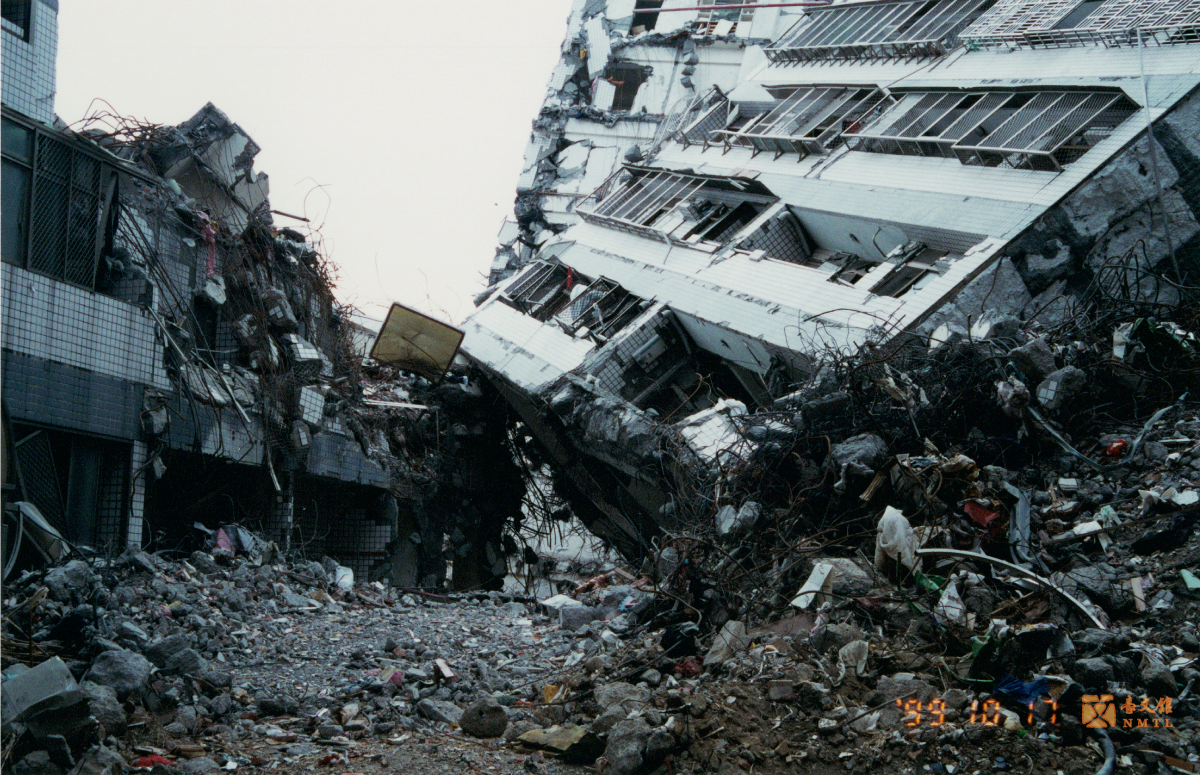
✺ Photos by Wang Shuan-bao, Collapse of Taichung Wangchao buildings during the 921 Earthquake
On September 21, 1999, an earthquake struck Taiwan. The most severely affected places included Taichung County, and Nantou County. Two of Taichung Wangchao buildings in Dali City, Taichung County, collapsed. Photo by Wang Shuang-bao. Date: October 17, 1999.(Authorized by National Museum of Taiwan History)
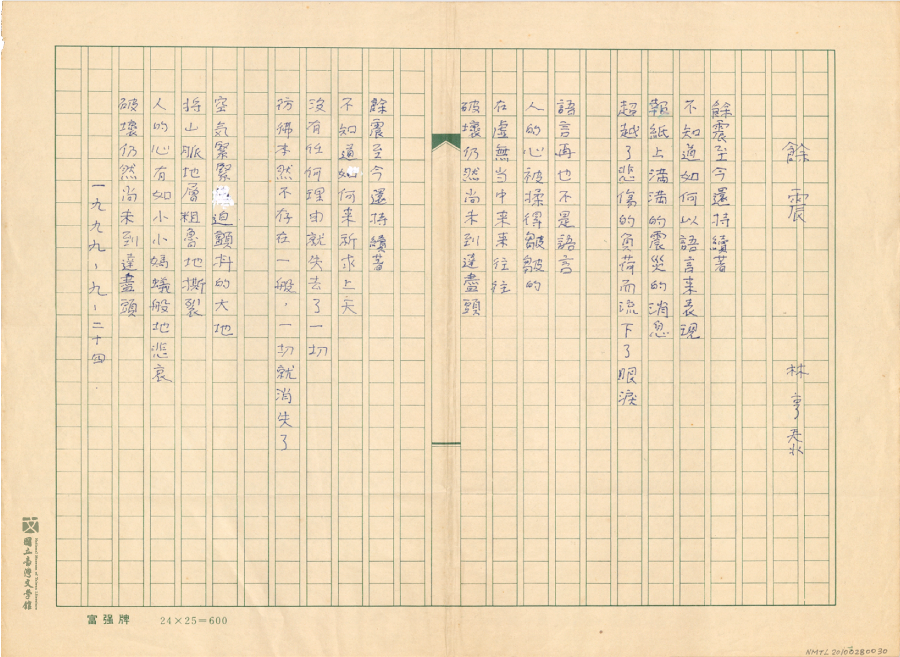
✺ "Aftershock"
Lin Heng-tai (1924-2023) illustrates how survivors continue to face aftershock; while they suffer from indescribable pain, they are deeply afraid that they would lose everything suddenly as the disaster seems to continue.(Donated by the Literary Taiwan Foundation/ Kept in National Museum of Taiwan Literature)
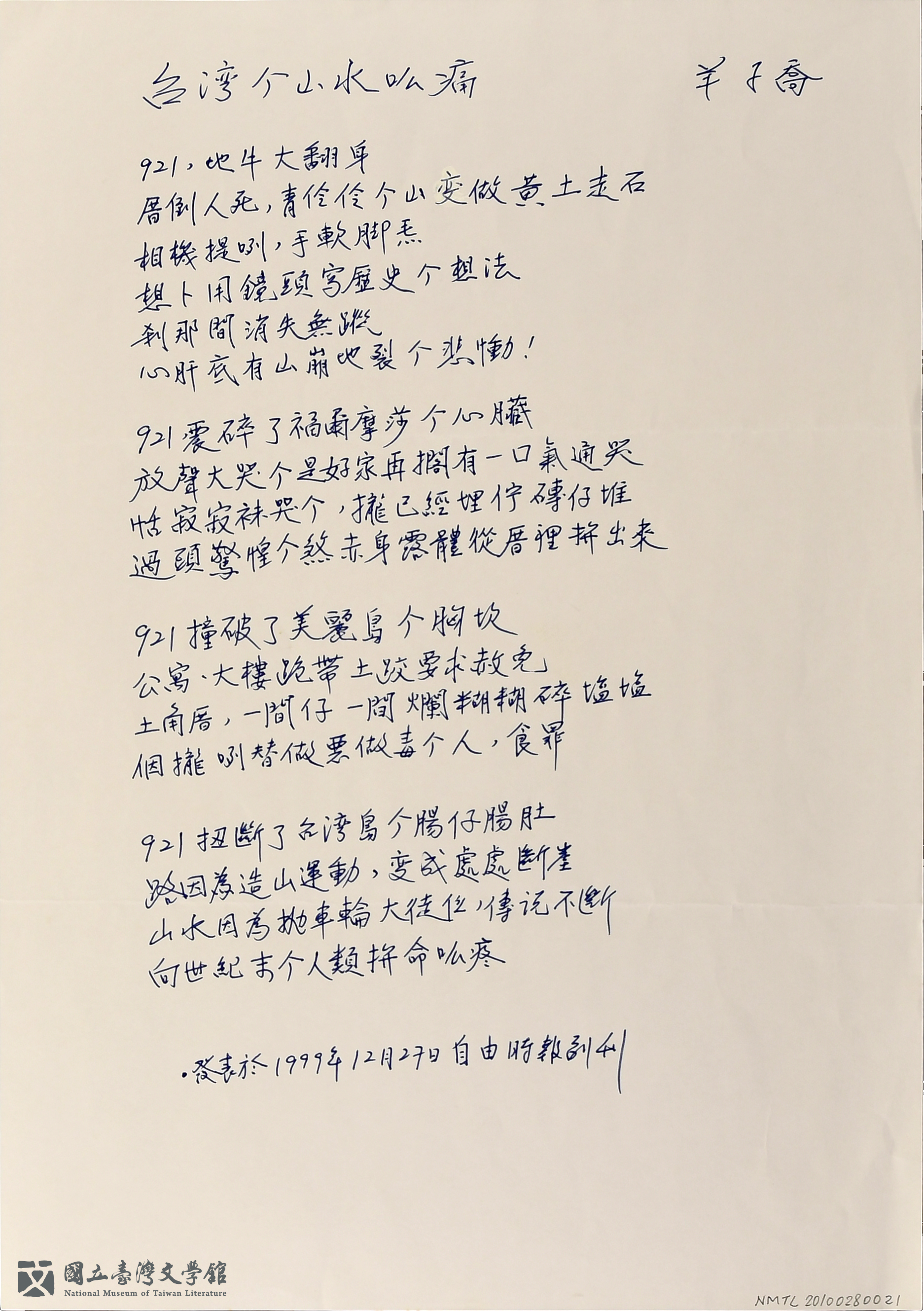
✺ "Taiwan's Mountains and Waters are Hurting"
In this writing, Yang Zi-qiao (1951-2019) personifies Taiwan and depicts the incurable pain caused by the 921 Earthquake; it is as if the earthquake had shattered the heart of Taiwan, ruptured its chest, and wrecked its stomach.(Donated by the Literary Taiwan Foundation/ Kept in National Museum of Taiwan Literature)

Literature Gives Voice to Silent Pains
Economic development and public infrastructure contribute to convenient lifestyles and remarkable economic growth. However, the workers that helped build Taiwan's public infrastructure and facilitated the economic growth suffered from work injuries. As government agencies and large-scale corporations paid no attention to them, the workers were unable to receive proper treatment and care physically and mentally.
Literature provides a platform for speaking about work injuries and investigating the causes. Literature also reminds unharmed people that convenience and progress can never be taken for granted as they have been hard-earned through the effort of people from all walks of life.
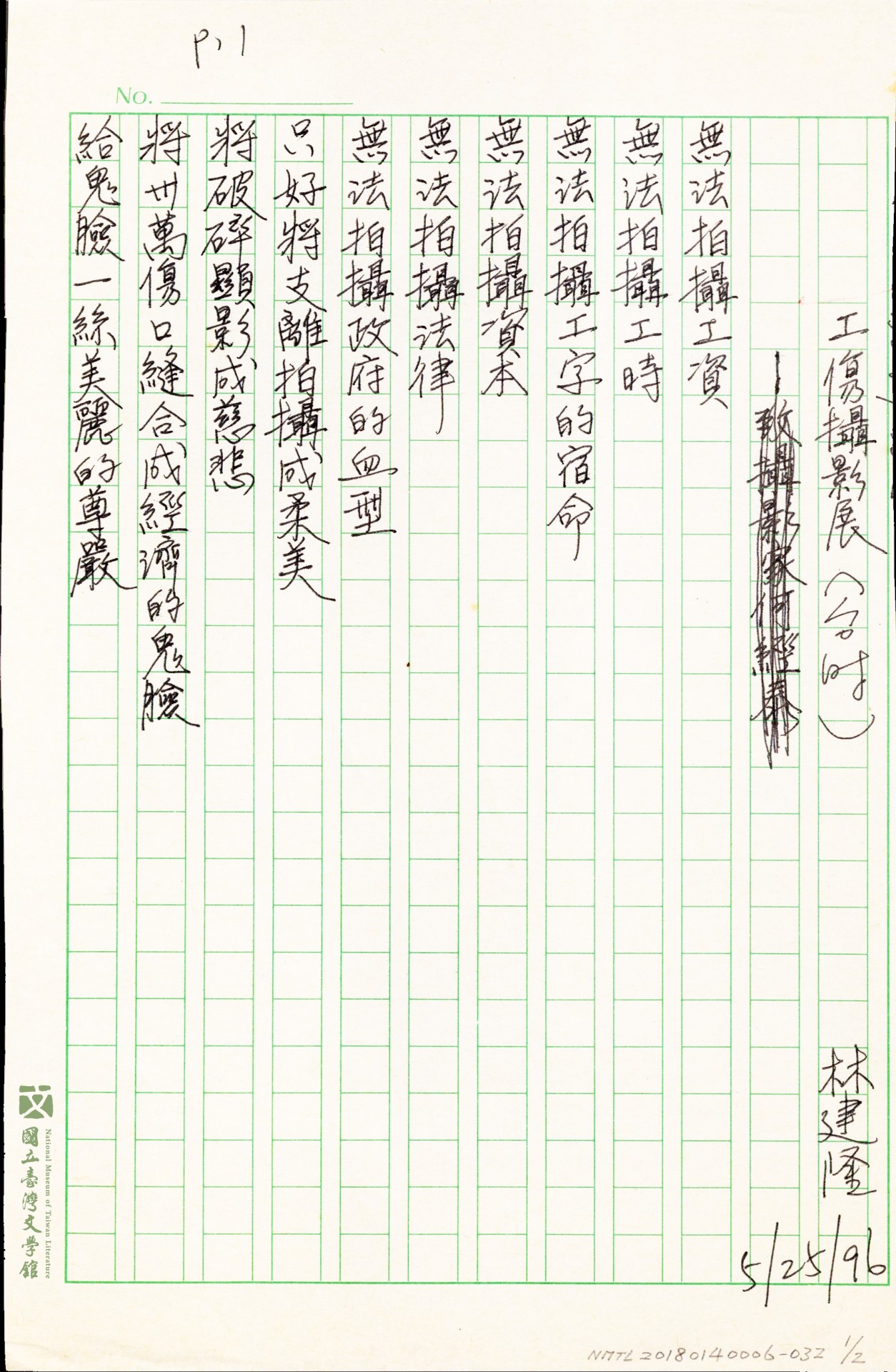
✺ "Photo Exhibition of Work Injuries," THE SPRING OF MISCANTHUS FLORIDULUS
The father of Lin Chien-lung (1956-) used to be a miner and one of his arms was severed during a mine disaster. Entitled "Photo Exhibition of Work Injuries," the poem narrates the impossibility to easily calculate the contributions made by blue-collar workers to Taiwan's economy. Yet these workers are exploited through law by the government against the backdrop of capitalism and live an existence that people look down upon.(Donated by Lin Chien-lung/ Kept in National Museum of Taiwan Literature)
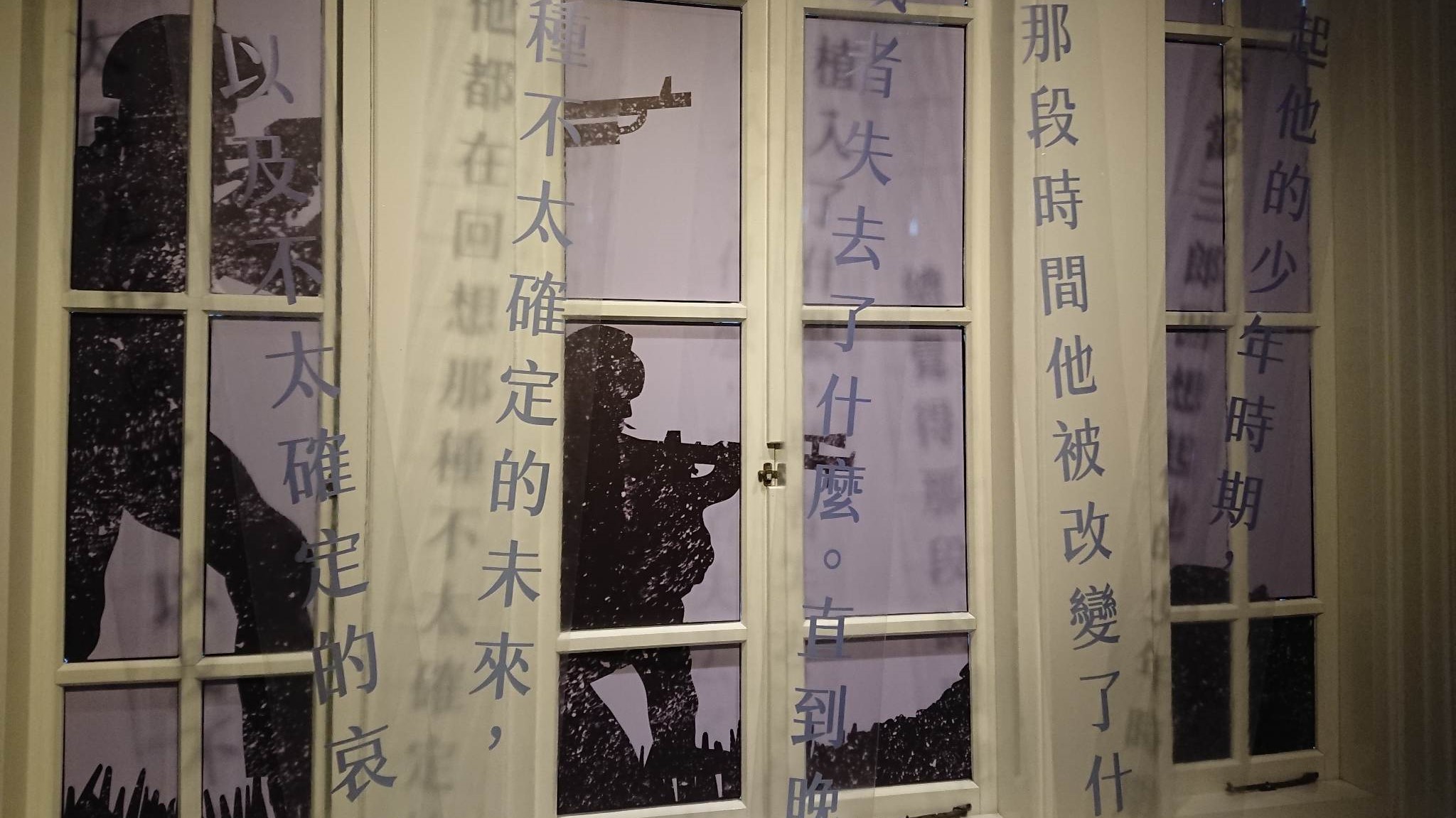
War's Clamor vs. Literature's Quietude
Wars are accompanied by flames and flying shells. Soldiers try to survive in the midst of bombing; they also are faced with the very moments when their comrades and enemies die. Even though the war ends one day, war participants must relive the war in their memories.
Throughout its history, Taiwan has been through multiple wars. During the Second World War, Taiwan did not become a battlefield, but suffered from air raids. Insomnia, anxiety and unstoppable rumination are often symptoms of post-war PTSD. Losing comrades, witnessing death and injuries, and the blaring sounds of bombing and shooting leave deep emotional scars and disturb the victims' lives.
Literature probes into the traumas of people with PTSD and the moments when the trauma happened. Readers can revisit the war scenes and take a closer look at the injured soldiers. Literature also reveals the lives of civilians in war. Literature may not be able to turn back the clock, yet only by looking back on history and exposing the scars can healing begin.
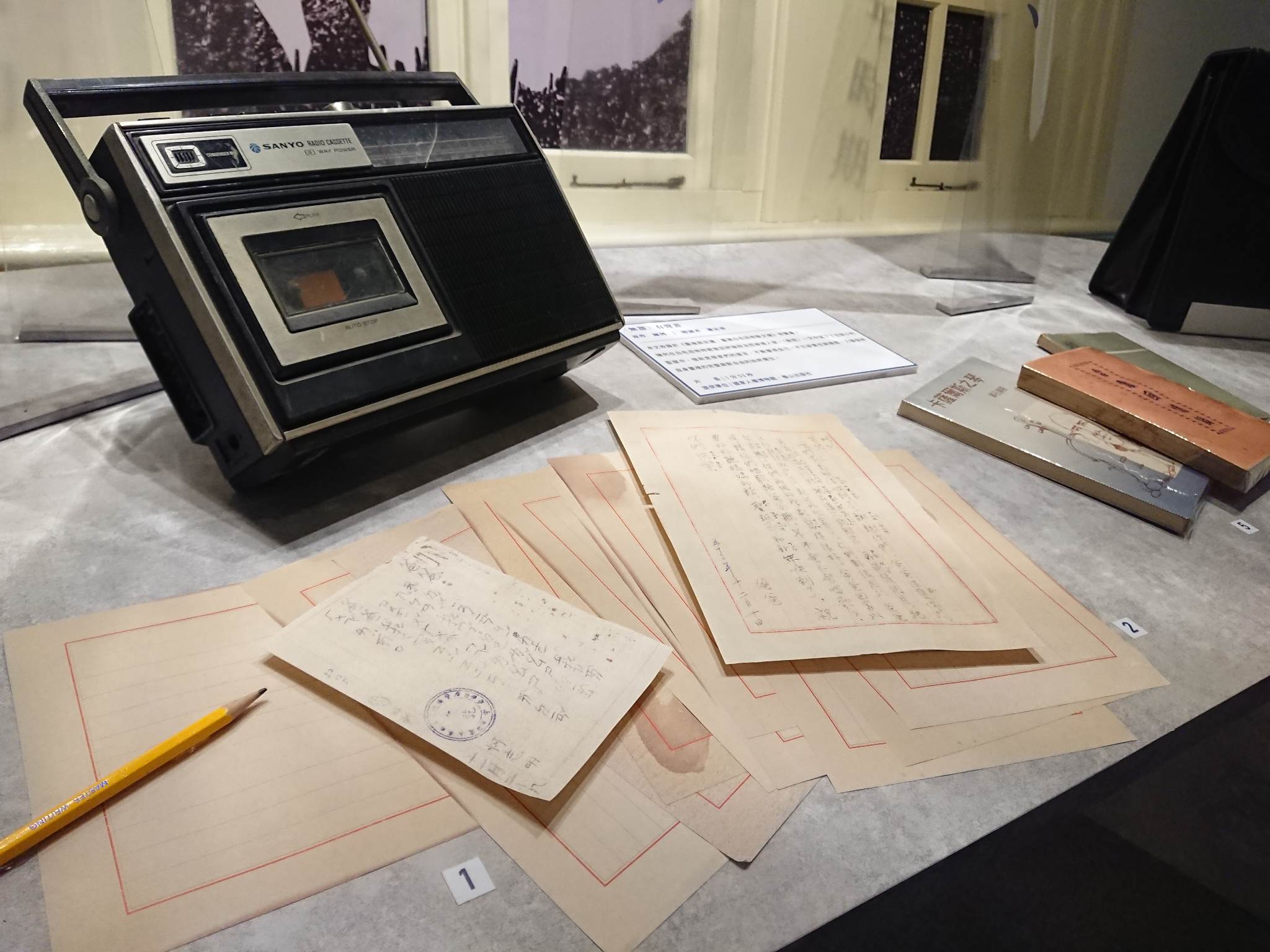
Navigating Memories, Rectifying History
Taiwan went through a martial law period of 38 years. Under the authoritarian regime, there was large-scale state surveillance and an unjust justice system, leading to multiple irreparable cases of human rights infringement. In the past, the authoritarian state hid its unjust doings in the dark; nevertheless, through the effort of individuals, the classified files are now being exposed, allowing people to peak into a part of "the martial law system."
"Our memories about the authoritarian period are so vague that after more than 30 years of democratization, we are now still clarifying and arguing about the exact number of people that were shot and prisoned during that time,"
writes Hu Shu-wen in the preface of A SELECTION OF WHITE TERROR NOVELS. Literature leads readers to the time and space of the authoritarian period and allows readers to learn about the remainder of the victims' lives. Before heading towards reconciliation, one must not forget.
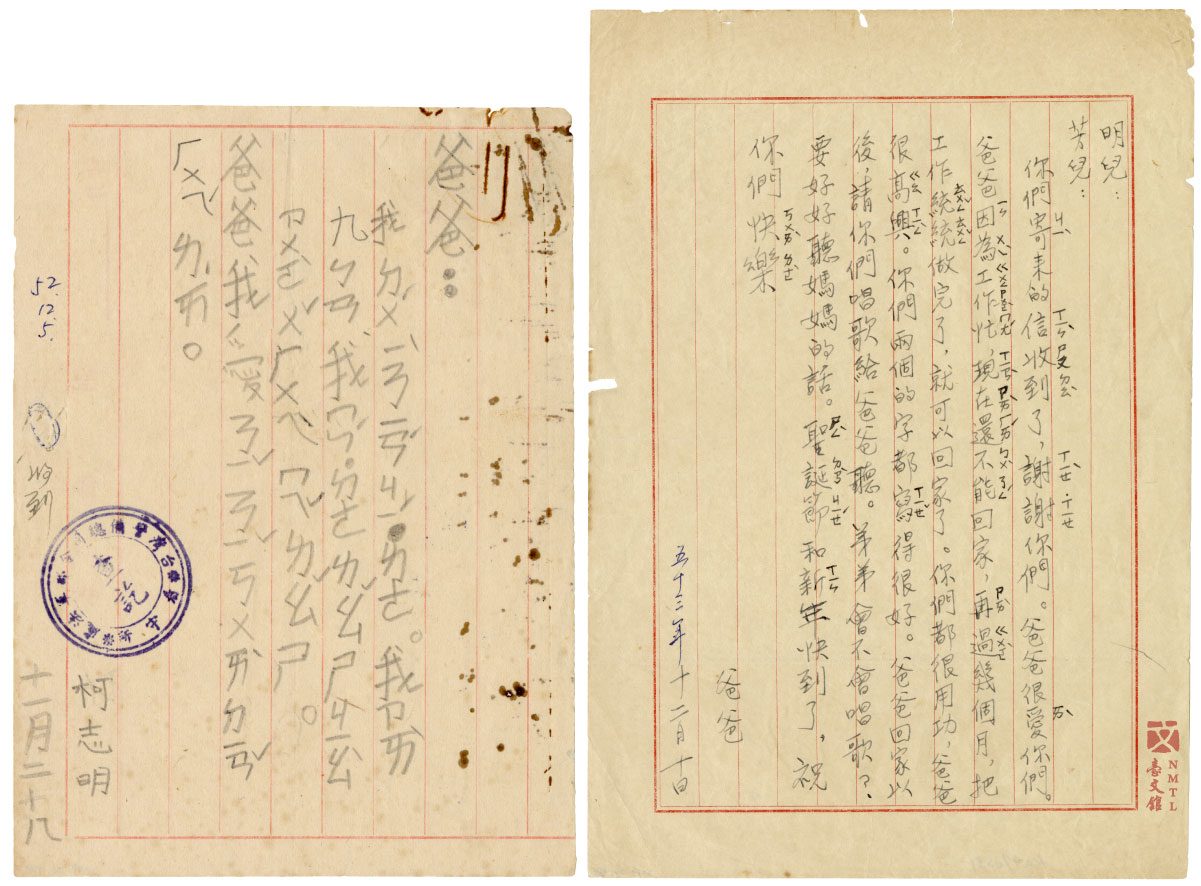
✺ Letters from Ke Qi-hua in prison to his family
These are two letters dated November 28, 1963, and December 10, 1964, written by Ke Qi-hua (1929-2002) to his family. Since he was still in prison when he wrote the letters, there was a word limit for letters sent to the outside and what was written was also censored.(Authorized by National Museum of Taiwan History)
✺ Audio Book of "No Complaint" by Chen Lieh; read by Dean Hsiao
This article is included in the audio book: SOUL AND ASHES: A COLLECTION OF PROSE FROM TAIWAN'S WHITE TERROR PERIOD. Chen Lieh (1946-) was sent to prison during the white terror period due to his political criticisms. In "No Complaint," he writes about how he reflected on himself in the small prison cell with the help of the words from great thinkers; by not forgetting his responsibilities and ideals, he strived to maintain the wholeness of his soul and his persistent yearning for freedom.(Authorized by National Human Rights Museum and Spring Hill Publishing)
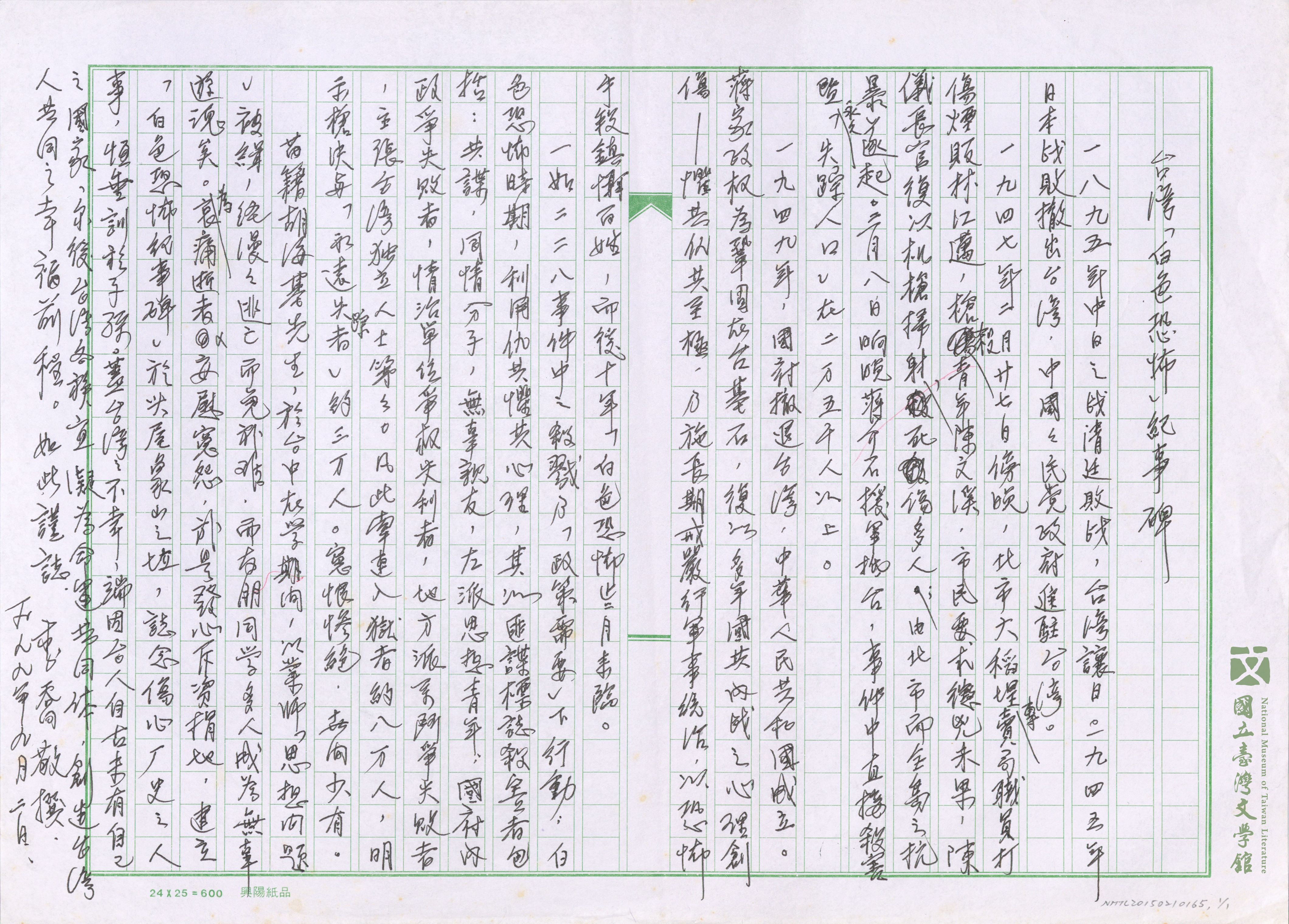
✺ "Monument of Taiwan's 'White Terror'"
Li Chiao (1934-) wrote the text of the monument for commemorating the innocent victims during the white terror period. At the end of the writing, Li hopes that every community should work together and strive for a future of happiness.(Donated by Li Chiao/ Kept in National Museum of Taiwan Literature)

✺ "The Peace Opera"
"The Peace Opera" is a type of outdoor theater performed by Hakka people to pay tribute to deities after celebrating the fall harvest. Dupan Fangge (1927-2016) likens the audience of the peace opera to Taiwanese people under authoritarian rule. They had to be obediently "peaceful" to survive and to watch "the peace opera."(Donated by Dupan Fangge/ Kept in National Museum of Taiwan Literature)

